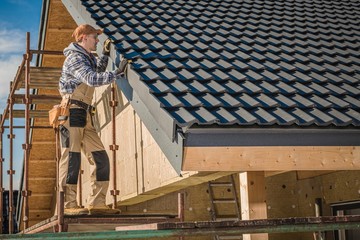Roofing Materials
Roofing materials vary according to their composition. Asphalt, a bituminous organic material, is commonly used for composition shingles. Roofing materials also include primer, shingles, and asphalt roof cement, which conforms to ASTM D4586 (Asbestos-free) standards. The drip edge is an overhang that prevents water from rolling around the shingles. Drip edges are made of asphalt and paper and are installed at the junction of two roofs.

Roofing is a specialty of construction and design. Despite the many benefits that come with flat roofs, there are many factors to consider when choosing a type of roof. A poorly constructed roof can cause a wide range of negative effects. While a flat roof with minimal runoff will protect against rain and snow, a steeply-pitched roof will not provide adequate protection from wind-driven rain. Roofing material selection and installation should be carefully considered and completed by a professional.
Roofing felts, also known as ply sheets, are typically reinforced with an organic or glass-fiber mat. They are then covered with a bitumen compound, typically asphalt or coal tar. These materials are self-adhesive and waterproof and are easy to customize for odd-shaped roofing sections. Some of these materials require a minimum amount of heating before they can be applied. However, synthetic underlayment may be suitable if you have a sloping roof.
Roofing materials come in a variety of different colors and materials. Typically, shingles are flat or curved and interlock with one another to channel water off the roof. Roofing materials can be made of many different materials, including wood, slate, flagstone, and metal. Roofing materials differ depending on the climate, the pitch of the roof, and the desired aesthetic. The choice of material depends on your preferences and budget. In some regions of the world, ceramic roof tiles are the most common type of roof material. They are still widely used, though they tend to deteriorate faster than wall shingles.
Metal roofing is another type of roofing material that is relatively inexpensive and long-lasting. Most asphalt shingle roofs have a lifespan of fifteen to twenty years. Other types of roofing material are available with lifespans of up to 100 years. While some of these roofing materials are expensive, they are easy to maintain. Metal roofs are also resistant to high winds and hail. The cost of metal roofing varies, depending on where you live and its durability.
The earliest roofs were probably thatched. These roofs were typically pitched or sloped to drain rainwater. Eventually, timbers were used to span roofs. This type of roof supported thick clay, eventually giving it a smoother finish. Eventually, thick timbers were used as support. Some types of wood shingles are used for the roof. A wood roof is often constructed by splitting trees, but it is not very common today.
Another important feature of a roof is the pitch, which is the angle formed by two sloping roof surfaces. The hip is the upper edge of the roof, while the gable is the triangular wall underneath the two roof planes. Roof pitches can be flat or sloped, so the material for the hips will be different. However, shingles are still the most common choice among homeowners. These materials will protect against storms and ensure that your roof is always safe.
A home is not complete without the proper roof framing. A roof frame supports layers of a material called decking, which is supported by the roof frame. Several layers of the roof rest on the decking. A dormer is a small structure that projects from the sloped roof. A gable roof has a slanting edge that extends over the end wall of the house. The eave and fascia are flat boards at the cornice edge. A shingle is secured with a thin layer of asphalt-saturated material called felt.
In addition to measuring for a new roof, you can also assess the condition of your current roof. A gable roof is relatively easy to measure, while a mansard or gambrel roof requires more complex calculations. These complicated roofing projects often involve waste since shingles must be cut to fit in tight spaces or nailed in even rows on the roof deck. Moreover, not every square foot of a roof is the same size. A phrase is known as “roof square” helps bridge the gap between simple and complex projects.
Clay or ceramic tiles are good options for roofing. They look like elongated S shapes and can be used on Spanish-style adobe homes. They are also incredibly durable. Slate tiles can last for more than 100 years, though they are more expensive than shingles. On the other hand, Clay tile is the oldest type of roofing material. It has its roots in glazed earthenware rooftops. Whether you decide to use clay or asphalt, you should make sure the structure can support the weight.
